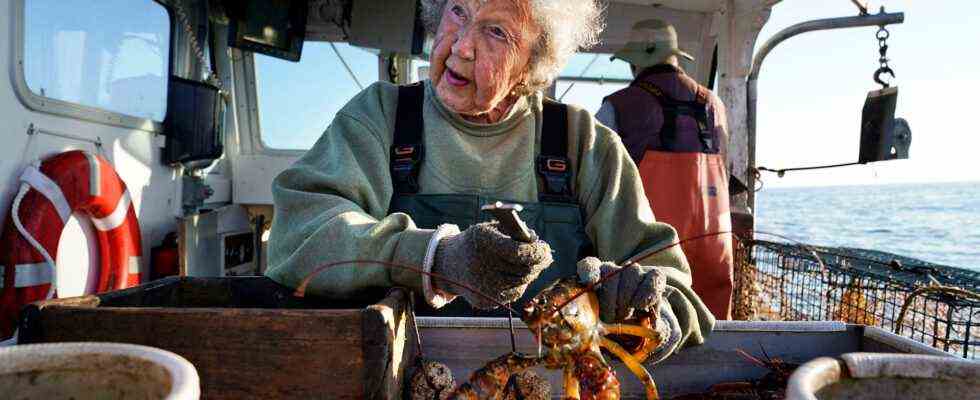Status: 31.10.2021 12:29 p.m.
The US state of Maine is known for its lobsters. Whole regions live from the shellfish. New rules to protect whales are fueling concerns among fishermen who fear for their future.
The small fishing village of Vinalhaven can only be reached by ferry from the mainland. Most of the time tourists sit on deck. You come to stroll through the city center of the picturesque island, through the bookshops and small boutiques. And: You come for the lobsters. Because in Vinalhaven is the Fisherman’s Cooperative, a cooperative of more than 80 fishermen who deliver boxes full of fat, crawling lobsters every day.
But many of the fishermen are not in a good mood because of a new animal welfare ordinance, says their boss Millie Martin: “If you take a closer look at Vinalhaven, then the lobster catch is the source of income here. And if the lobster catch is limited or at some point completely eliminated, what happens then with the islanders? It would affect everything. “
Martin says a good three quarters of the community’s residents worked in fishing or processed marine animals – including the lobster that is delivered through their pier – and earned their living with it. Many families depend on the shellfish, often several generations among the fishermen. “It’s a family business,” says Martin. “The grandparents, parents and children all fish.”
Right whales get tangled on the ropes
Now she fears for her income. The reason is the “right whale”, the right whale: After the gigantic animals were hunted on a massive scale in the past centuries, experts estimate that around 360 specimens still live in the world today. It’s not just majestic animals. They are also important for the sea and the climate. The excretions of the whales fertilize the surface water and thus microscopic algae. These in turn bind the CO2 from the atmosphere. So whales also help in the fight against climate change.
The right whale is considered to be important for the oceans and the climate – and is seriously threatened.
Image: dpa
But: A threat lurks in the Gulf of Maine: the equipment of the lobster fishermen. “When these animals swim through the Gulf of Maine, they get tangled,” says Barbara Skapa of the Mainers Guarding Right Whales group. Because the lobster fishermen drop their metal traps – large angular baskets – on long ropes, attached to buoys. A lobster fisherman can set up to 800 traps.
In Maine, however, there are around 5,000 such fishermen – more than in any other US state. For the whales, this means in parts that they have to swim through a maze of millions of ropes. The animals often panicked, says Skapa. And trying to break free from the ropes will only get them tangled up even more. Some perish.
Frustration among the fishermen
To protect them, the United States Oceanography Agency has now created a large protection zone off the Maine coast. Lobster fishermen will no longer be allowed to set traps there in the coming months. This should reduce tangling by up to 70 percent.
Many lobster fishermen, on the other hand, say: It just creates a new problem. “This will create a real curtain of equipment, a wall of lobster traps,” says Sam Rosen, a suntanned lobster fisherman in Vinalhaven in his twenties and a colleague of Millie Martin. By January the fishermen will have to share the remaining space on the coast. To the disadvantage, possibly, of other marine animals.
The lobsters are caught in metal traps that are lowered from the boats.
Image: AP
Rosen is stressed – and annoyed. He does not yet know how much loss he will make. But: “You can calculate the loss on the basis of the lost equipment,” says Rosen, “on the basis of the lost time and the massive changes in terms of effort and materials.” Because the fishermen now also have to use weaker ropes so that the whales can tear themselves away more easily.
Zack Klyver, whale fan and co-founder of the consulting firm Blue Planet Strategies, is working on a solution to the fishermen’s dilemma. Their concept: lobster traps without any ropes. The traps can, for example, be equipped with a transmitter that notifies the fisherman of his location in the sea via an acoustic signal. After a signal from the boat, the basket comes full back to the surface.
High costs for ropeless catching
The catch, as is so often the case with innovation: the technology is not yet fully developed. And at the moment, such a trap costs around $ 4,000 instead of the usual $ 80 to $ 200.
“So all in all, we’re talking about $ 300,000 to $ 400,000 to switch to ropeless fishing,” says Zack Klyver. That’s a lot of money for a lobster fisherman. And even if politicians pay some fishermen to test the technology, the fishermen hope in vain for fundamental financial support. “There is currently no subsidy for new equipment,” says Klyver.
For Millie Martin and her colleagues in Vinalhaven, that means: wait and see how many lobsters find their way into their baskets despite the trap jam. And there is fear for the future of the fishing village of Vinalhaven.
Good for the whales – bad for the lobster fishermen?
Franziska Hoppen, ARD Washington, October 29, 2021 2:53 p.m.

